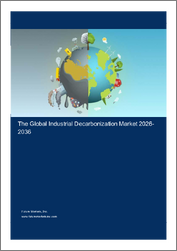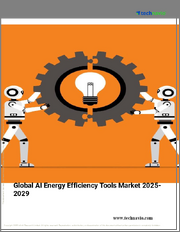
|
시장보고서
상품코드
1530879
에너지 효율 시장 예측(-2030년) : 서비스 유형별, 최종사용자별, 지역별 세계 분석Energy Efficiency Market Forecasts to 2030 - Global Analysis By Service Type (Operational and Maintenance Services, Heating, Ventilation and Air Conditioning, Energy Management Systems and Other Service Types), End User and By Geography |
||||||
Stratistics MRC에 따르면 세계의 에너지 효율 시장은 예측 기간 중 14.6%의 CAGR로 성장하고 있습니다.
에너지 효율이란 편안함, 품질, 성능을 희생하지 않고 가정내 난방이나 가전제품에 전력을 공급하는 등 동일한 작업을 더 적은 에너지로 수행하는 것을 말합니다. 에너지 효율은 에너지 낭비를 최소화하고 에너지 사용을 최적화하는 것을 포함하며, 일반적으로 기술 발전, 프로세스 개선 및 행동 변화를 통해 이루어집니다. 에너지 효율적 관행과 기술은 에너지 소비를 줄이고 온실 가스 배출을 줄이며 유한한 에너지 자원에 대한 의존도를 줄이는 것을 목표로 합니다. 에너지 효율의 주요 측면에는 에너지 효율이 높은 가전제품, 조명, 건축자재, 산업 및 상업 부문의 에너지 관리 시스템 및 관행의 도입이 포함됩니다.
도시화 및 인프라 구축
도시화와 인프라 구축은 기술, 교통, 자원 관리의 발전을 촉진하고 에너지 효율을 높이는 데 있으며, 매우 중요한 역할을 합니다. 도시가 확장되고 현대화됨에 따라 지속가능한 관행과 스마트 기술의 통합에 대한 중요성이 커지고 있습니다. 효율적인 도시 계획은 녹색 건축 기준, 최적화된 대중교통 시스템, 재생 에너지 도입 등의 노력을 통해 에너지 소비를 줄일 수 있습니다. 인프라 구축은 에너지 효율이 높은 조명 및 가전제품으로의 전환, 폐기물 관리 프로세스 개선, 전기자동차 사용 촉진 등 노후화된 시스템을 업그레이드함으로써 이러한 노력을 지원합니다.
규제 및 정책의 불확실성
규제 및 정책의 불확실성은 에너지 효율화를 추진하는 데 있으며, 큰 장벽이 될 수 있습니다. 기업과 투자자들은 에너지 효율 기술 및 관행에 대한 정보에 입각한 의사결정과 투자를 위해 명확하고 안정적인 규제에 의존하고 있습니다. 규제가 불투명하거나 자주 바뀌는 경우, 장기적인 효율성 향상을 위한 자원 투입을 주저하고 꺼리게 됩니다. 불명확한 정책은 시행과 집행에 일관성이 없어 의미 있는 에너지 절약 및 환경 목표 달성을 위한 노력을 더욱 복잡하게 만듭니다. 그러나 이러한 불확실성은 소비자의 신뢰와 에너지 효율이 높은 제품 및 서비스 채택에도 영향을 미칩니다. 소비자들은 정부의 지원과 인센티브가 신뢰할 수 있고 오래 지속될 것이라는 확신을 갖지 못하기 때문입니다.
국제협약과 약속
국제적인 협약과 약속은 전 세계에서 에너지 효율을 높이는 데 있으며, 매우 중요한 역할을 합니다. 이러한 협약은 일반적으로 여러 국가가 협력하여 산업, 운송, 건물 등 다양한 부문에서 에너지 소비를 줄이고 효율을 높이기 위한 목표, 기준, 정책을 수립하는 데에 초점을 맞추었습니다. 공동의 목표에 합의하고 베스트 프랙티스를 공유함으로써 각국은 공동의 지식과 자원을 활용하여 기술 발전과 에너지 효율적 관행의 채택을 가속화할 수 있습니다. 또한 국제 협약은 연구개발 구상, 자금 조달 메커니즘, 역량 개발 노력에 대한 협력 및 조정의 틀을 제공합니다. 국제 협약은 또한 진행 상황을 모니터링하고 개선점을 파악하는 데 필수적인 데이터와 정보의 교환을 용이하게 합니다.
고가의 초기 비용
높은 초기 비용은 다양한 분야에서 에너지 효율을 높이는 데 있으며, 큰 장벽이 되고 있습니다. 가전제품, 조명, 난방 및 냉방 시스템과 같은 에너지 효율 기술에 대한 투자는 많은 초기 자본 지출이 필요한 경우가 많으며, 많은 소비자와 기업이 이를 부담스러워하는 경우가 많습니다. 에너지 소비를 줄임으로써 장기적으로 비용을 절감할 수 있음에도 불구하고, 단기적인 금전적 부담으로 인해 이해관계자들이 이러한 기술을 채택하지 못하는 경우가 많습니다. 그러나 예산이 빠듯하거나 불확실한 경제 상황에 직면한 산업 및 기업의 경우, 에너지 효율 개선에 자금을 투입하는 것은 다른 당면한 운영 비용에 비해 우선순위가 낮을 수 있습니다.
COVID-19의 영향 :
COVID-19는 전 세계 에너지 효율 동향에 큰 영향을 미쳤습니다. 봉쇄와 제한으로 인해 산업, 운송 및 상업 활동이 감소하여 에너지 수요가 일시적으로 감소했습니다. 이러한 변화로 인해 조직은 에너지 소비 패턴과 운영 효율성을 재평가해야 했습니다. 원격 근무는 에어컨 관리 개선과 조명 필요성의 감소를 통해 사무실 건물의 에너지 절약 잠재력을 부각시켰습니다. 그러나 팬데믹은 또한 경제의 불확실성 속에서 에너지 효율에 대한 투자와 약속을 유지하는 데 있어서의 도전과제를 부각시켰습니다.
예측 기간 중 난방-환기-공조 분야가 가장 큰 비중을 차지할 것으로 예상됩니다.
예측 기간 중 난방, 환기 및 공조 부문이 가장 큰 성장을 보일 것으로 예상됩니다. 최신 HVAC 시스템에는 가변 속도 모터 및 스마트 온도 조절기와 같은 첨단 기술이 통합되어 실시간 상황과 수요에 따라 작동을 조정하여 에너지 사용량을 최적화합니다. 개선된 단열 및 밀폐 기술은 에너지 손실을 최소화하고 조절된 공기가 건물 외벽에 유지될 수 있도록 합니다. 또한 에너지 효율이 높은 HVAC 시스템은 고효율 필터와 부품을 사용하여 실내 공기질을 최적으로 유지하면서 전체 에너지 소비를 줄입니다.
예측 기간 중 가장 높은 CAGR을 나타낼 것으로 예상되는 분야는 상업용 부문입니다.
예측 기간 중 가장 높은 CAGR을 보일 것으로 예상되는 분야는 상업 부문입니다. 상업 부문에서 에너지 효율을 개선하기 위해서는 생산성을 유지하거나 향상시키면서 에너지 소비를 줄이는 기술 및 방법을 도입하는 것이 중요합니다. 이러한 접근 방식은 운영 비용을 절감할 뿐만 아니라 탄소발자국을 최소화함으로써 환경적 지속가능성 목표에도 부합합니다. 기업은 에너지 효율이 높은 장비로 업그레이드하고, HVAC 시스템을 최적화하고, 스마트 조명 솔루션을 도입하고, 에너지 사용 패턴을 모니터링하고 제어하는 에너지 관리 시스템을 도입하는 등 다양한 방법을 통해 에너지 효율을 달성하고 있습니다.
가장 큰 점유율을 차지하는 지역
추정 기간 중 유럽이 가장 큰 시장 점유율을 차지했습니다. 이 지역의 정부 및 규제기관은 이 지역의 기업과 개인이 보다 지속가능한 관행을 채택하도록 장려하기 위해 다양한 인센티브 프로그램을 시행하고 있습니다. 이러한 인센티브는 종종 보조금, 보조금, 세금 감면, 저금리 융자 등의 형태로 제공되며, 지역 전체에서 에너지 효율적 기술 및 관행으로 업그레이드하는 데 드는 초기 비용을 상쇄하는 데 도움이 됩니다. 이러한 인센티브는 경제적 부담을 줄이고 에너지 비용 절감 및 환경적 성능 향상과 같은 가시적인 혜택을 제공함으로써 이해관계자들이 지역 전체에서 에너지 효율적 솔루션에 투자할 수 있는 동기를 부여합니다.
CAGR이 가장 높은 지역 :
유럽은 예측 기간 중 수익성 높은 성장을 이룰 것으로 예상됩니다. 유럽 전역의 에너지 효율을 높이는 데 있으며, 유틸리티 프로그램이 중요한 역할을 하고 있습니다. 이러한 프로그램은 지역내 소비자와 기업이 보다 에너지 효율적인 관행과 기술을 채택하도록 장려하기 위해 전력회사들이 설계하고 시행하고 있습니다. 지속가능성과 탄소 배출량 감소가 강조되는 유럽에서 유틸리티 프로그램은 정부와 유럽연합이 설정한 에너지 효율 목표 달성에 큰 기여를 하고 있습니다.
무료 커스터마이징 서비스
이 보고서를 구독하는 고객은 다음과 같은 무료 맞춤화 옵션 중 하나를 사용할 수 있습니다. :
- 기업 개요
- 추가 시장 기업의 종합적인 프로파일링(최대 3사)
- 주요 기업의 SWOT 분석(최대 3사)
- 지역 세분화
- 고객의 관심에 따른 주요 국가별 시장 추정치, 예측, CAGR(주: 타당성 확인에 따라 다름)
- 경쟁사 벤치마킹
- 제품 포트폴리오, 지역적 입지, 전략적 제휴를 기반으로 한 주요 기업 벤치마킹
목차
제1장 개요
제2장 서문
- 개요
- 이해관계자
- 조사 범위
- 조사 방법
- 데이터 마이닝
- 데이터 분석
- 데이터 검증
- 조사 어프로치
- 조사 정보원
- 1차 조사 정보원
- 2차 조사 정보원
- 전제조건
제3장 시장 동향 분석
- 촉진요인
- 억제요인
- 기회
- 위협
- 최종사용자 분석
- 신흥 시장
- COVID-19의 영향
제4장 Porter's Five Forces 분석
- 공급 기업의 교섭력
- 바이어의 교섭력
- 대체품의 위협
- 신규 진출업체의 위협
- 경쟁 기업 간 경쟁 관계
제5장 세계의 에너지 효율 시장 : 서비스 유형별
- 운영·유지보수 서비스
- 난방, 환기, 공조
- 에너지 관리 시스템(EMS)
- 기타 서비스 유형
제6장 세계의 에너지 효율 시장 : 최종사용자별
- 산업
- 상업
- 자동차·운송
- 기타 최종사용자
제7장 세계의 에너지 효율 시장 : 지역별
- 북미
- 미국
- 캐나다
- 멕시코
- 유럽
- 독일
- 영국
- 이탈리아
- 프랑스
- 스페인
- 기타 유럽
- 아시아태평양
- 일본
- 중국
- 인도
- 호주
- 뉴질랜드
- 한국
- 기타 아시아태평양
- 남미
- 아르헨티나
- 브라질
- 칠레
- 기타 남미
- 중동 및 아프리카
- 사우디아라비아
- 아랍에미리트
- 카타르
- 남아프리카공화국
- 기타 중동 및 아프리카
제8장 주요 발전
- 계약, 파트너십, 협업, 합병사업
- 인수와 합병
- 신제품 발매
- 사업 확대
- 기타 주요 전략
제9장 기업 프로파일링
- Eaton Corporation
- Exelon Corporation
- General Electric
- Honeywell International, Inc
- Johnson Controls International PLC
- Lockheed Martin Advanced Energy Storage, LLC
- Ontario Power Generation
- Ormat Technologies, Inc
- Rockwell Automation
- Siemens AG
- Trane Technologies
According to Stratistics MRC, the Global Energy Efficiency Market is growing at a CAGR of 14.6% during the forecast period. Energy efficiency refers to using less energy to perform the same task, such as heating a home or powering appliances, without sacrificing comfort, quality, or performance. It involves minimizing energy waste and optimizing energy use, typically through technological advancements, improved processes, or behavioral changes. Energy-efficient practices and technologies aim to reduce energy consumption, lower greenhouse gas emissions, and decrease reliance on finite energy resources. Key aspects of energy efficiency include the adoption of energy-efficient appliances, lighting, and building materials, as well as implementing energy management systems and practices in industrial and commercial sectors.
Market Dynamics:
Driver:
Urbanization and infrastructure development
Urbanization and infrastructure development play crucial roles in enhancing energy efficiency by fostering advancements in technology, transportation, and resource management. As cities expand and modernize, there is a growing emphasis on sustainable practices and the integration of smart technologies. Efficient urban planning can lead to reduced energy consumption through initiatives like green building standards, optimized public transportation systems, and the implementation of renewable energy sources. Infrastructure development supports these efforts by upgrading outdated systems, such as transitioning to energy-efficient lighting and appliances, improving waste management processes, and promoting the use of electric vehicles.
Restraint:
Regulatory and policy uncertainty
Regulatory and policy uncertainty poses a significant barrier to advancing energy efficiency initiatives. Businesses and investors rely on clear, stable regulations to make informed decisions and investments in energy-efficient technologies and practices. When regulations are uncertain or frequently changing, it creates hesitancy and reluctance to commit resources towards long-term efficiency improvements. Unclear policies can lead to inconsistency in implementation and enforcement, further complicating efforts to achieve meaningful energy savings and environmental goals. However, this uncertainty also affects consumer confidence and adoption of energy-efficient products and services, as they may be unsure about the reliability and longevity of government support and incentives.
Opportunity:
International agreements and commitments
International agreements and commitments play a crucial role in enhancing energy efficiency on a global scale. These agreements typically involve multiple countries coming together to set targets, standards, and policies aimed at reducing energy consumption and improving efficiency across various sectors such as industry, transportation, and buildings. By agreeing on common goals and sharing best practices, countries can leverage collective knowledge and resources to accelerate technological advancements and adoption of energy-efficient practices. Furthermore, international agreements provide a framework for cooperation and coordination on research and development initiatives, funding mechanisms, and capacity-building efforts. They also facilitate the exchange of data and information, which is essential for monitoring progress and identifying areas for improvement.
Threat:
High upfront costs
High upfront costs are a significant barrier to enhancing energy efficiency in various sectors. Investments in energy-efficient technologies such as appliances, lighting, heating, and cooling systems often require substantial initial capital outlay, which many consumers and businesses find prohibitive. Despite the long-term cost savings from reduced energy consumption, the immediate financial burden dissuades stakeholders from adopting these technologies. However, for industries and businesses operating on tight budgets or facing uncertain economic conditions, allocating funds towards energy efficiency upgrades may not be a priority compared to other immediate operational expenses.
Covid-19 Impact:
The COVID-19 pandemic significantly influenced energy efficiency trends worldwide. Lockdowns and restrictions led to reduced industrial activity, transportation and commercial operations, causing a temporary drop in energy demand. This shift forced organizations to reassess energy consumption patterns and operational efficiencies. Remote working arrangements highlighted the potential for energy savings in office buildings through better HVAC management and reduced lighting needs. However, the pandemic also underscored challenges in maintaining energy efficiency investments and commitments amidst economic uncertainties.
The Heating, Ventilation and Air Conditioning segment is expected to be the largest during the forecast period
Heating, Ventilation and Air Conditioning segment is expected to be the largest during the forecast period. Modern HVAC systems incorporate advanced technologies such as variable-speed motors and smart thermostats, which optimize energy usage by adjusting operations based on real-time conditions and demand. Improved insulation and sealing techniques minimize energy loss, ensuring that conditioned air is retained within the building envelope. Additionally, energy-efficient HVAC systems also utilize high-efficiency filters and components that reduce overall energy consumption while maintaining optimal indoor air quality.
The Commercial segment is expected to have the highest CAGR during the forecast period
Commercial segment is expected to have the highest CAGR during the forecast period. In the commercial sector, enhancing energy efficiency involves implementing technologies and practices that reduce energy consumption while maintaining or improving productivity. This approach not only lowers operational costs but also aligns with environmental sustainability goals by minimizing carbon footprints. Businesses achieve energy efficiency through various means such as upgrading to energy-efficient equipment, optimizing HVAC systems, adopting smart lighting solutions, and implementing energy management systems that monitor and control usage patterns.
Region with largest share:
Europe region commanded the largest market share over the extrapolated period. Governments and regulatory bodies across the region have implemented various incentive programs aimed at encouraging businesses and individuals to adopt more sustainable practices across the region. These incentives often take the form of grants, subsidies, tax breaks, and low-interest loans, which help offset the initial costs of upgrading to energy-efficient technologies and practices throughout the region. By reducing the financial burden and offering tangible benefits, such as lower energy bills and improved environmental performance, these incentives motivate stakeholders to invest in energy-efficient solutions throughout the region.
Region with highest CAGR:
Europe region is projected to witness profitable growth during the forecast period. Utility programs are playing a crucial role in enhancing energy efficiency across Europe. These programs are designed and implemented by utility companies to encourage consumers and businesses to adopt more energy-efficient practices and technologies across the region. In the context of Europe, where there is a strong emphasis on sustainability and reducing carbon emissions, utility programs contribute significantly to achieving energy efficiency targets set by governments and the European Union.
Key players in the market
Some of the key players in Energy Efficiency market include Eaton Corporation, Exelon Corporation, General Electric, Honeywell International, Inc, Johnson Controls International PLC, Lockheed Martin Advanced Energy Storage, LLC, Ontario Power Generation, Ormat Technologies, Inc, Rockwell Automation, Siemens AG and Trane Technologies.
Key Developments:
In May 2024, US power management company Eaton has acquired UK thermal monitoring solution firm Exertherm. The company's Continuous Thermal Monitoring (CTM) sensors can be installed in electrical components such as Bus Ducts, LV/MV switchgear, MCCs, UPS, PDUs, and dry transformers. Permanently installed sensors monitor asset temperature changes and provide an early warning to alert personnel when and where a potential electrical failure may occur.
In March 2024, US power management company Eaton announced the launch of its new modular data center solution. Eaton's SmartRack modular data center combines racks, cooling, and service enclosures to withstand up to 150kW of equipment load. The solution is designed for organizations looking to meet the growing demand for edge computing, machine learning, and AI.
Service Types Covered:
- Operational and Maintenance Services
- Heating, Ventilation and Air Conditioning
- Energy Management Systems (EMS)
- Other Service Types
End Users Covered:
- Industrial
- Commercial
- Automotive and Transportation
- Other End Users
Regions Covered:
- North America
- US
- Canada
- Mexico
- Europe
- Germany
- UK
- Italy
- France
- Spain
- Rest of Europe
- Asia Pacific
- Japan
- China
- India
- Australia
- New Zealand
- South Korea
- Rest of Asia Pacific
- South America
- Argentina
- Brazil
- Chile
- Rest of South America
- Middle East & Africa
- Saudi Arabia
- UAE
- Qatar
- South Africa
- Rest of Middle East & Africa
What our report offers:
- Market share assessments for the regional and country-level segments
- Strategic recommendations for the new entrants
- Covers Market data for the years 2022, 2023, 2024, 2026, and 2030
- Market Trends (Drivers, Constraints, Opportunities, Threats, Challenges, Investment Opportunities, and recommendations)
- Strategic recommendations in key business segments based on the market estimations
- Competitive landscaping mapping the key common trends
- Company profiling with detailed strategies, financials, and recent developments
- Supply chain trends mapping the latest technological advancements
Free Customization Offerings:
All the customers of this report will be entitled to receive one of the following free customization options:
- Company Profiling
- Comprehensive profiling of additional market players (up to 3)
- SWOT Analysis of key players (up to 3)
- Regional Segmentation
- Market estimations, Forecasts and CAGR of any prominent country as per the client's interest (Note: Depends on feasibility check)
- Competitive Benchmarking
- Benchmarking of key players based on product portfolio, geographical presence, and strategic alliances
Table of Contents
1 Executive Summary
2 Preface
- 2.1 Abstract
- 2.2 Stake Holders
- 2.3 Research Scope
- 2.4 Research Methodology
- 2.4.1 Data Mining
- 2.4.2 Data Analysis
- 2.4.3 Data Validation
- 2.4.4 Research Approach
- 2.5 Research Sources
- 2.5.1 Primary Research Sources
- 2.5.2 Secondary Research Sources
- 2.5.3 Assumptions
3 Market Trend Analysis
- 3.1 Introduction
- 3.2 Drivers
- 3.3 Restraints
- 3.4 Opportunities
- 3.5 Threats
- 3.6 End User Analysis
- 3.7 Emerging Markets
- 3.8 Impact of Covid-19
4 Porters Five Force Analysis
- 4.1 Bargaining power of suppliers
- 4.2 Bargaining power of buyers
- 4.3 Threat of substitutes
- 4.4 Threat of new entrants
- 4.5 Competitive rivalry
5 Global Energy Efficiency Market, By Service Type
- 5.1 Introduction
- 5.2 Operational and Maintenance Services
- 5.3 Heating, Ventilation and Air Conditioning
- 5.4 Energy Management Systems (EMS)
- 5.5 Other Service Types
6 Global Energy Efficiency Market, By End User
- 6.1 Introduction
- 6.2 Industrial
- 6.3 Commercial
- 6.4 Automotive and Transportation
- 6.5 Other End Users
7 Global Energy Efficiency Market, By Geography
- 7.1 Introduction
- 7.2 North America
- 7.2.1 US
- 7.2.2 Canada
- 7.2.3 Mexico
- 7.3 Europe
- 7.3.1 Germany
- 7.3.2 UK
- 7.3.3 Italy
- 7.3.4 France
- 7.3.5 Spain
- 7.3.6 Rest of Europe
- 7.4 Asia Pacific
- 7.4.1 Japan
- 7.4.2 China
- 7.4.3 India
- 7.4.4 Australia
- 7.4.5 New Zealand
- 7.4.6 South Korea
- 7.4.7 Rest of Asia Pacific
- 7.5 South America
- 7.5.1 Argentina
- 7.5.2 Brazil
- 7.5.3 Chile
- 7.5.4 Rest of South America
- 7.6 Middle East & Africa
- 7.6.1 Saudi Arabia
- 7.6.2 UAE
- 7.6.3 Qatar
- 7.6.4 South Africa
- 7.6.5 Rest of Middle East & Africa
8 Key Developments
- 8.1 Agreements, Partnerships, Collaborations and Joint Ventures
- 8.2 Acquisitions & Mergers
- 8.3 New Product Launch
- 8.4 Expansions
- 8.5 Other Key Strategies
9 Company Profiling
- 9.1 Eaton Corporation
- 9.2 Exelon Corporation
- 9.3 General Electric
- 9.4 Honeywell International, Inc
- 9.5 Johnson Controls International PLC
- 9.6 Lockheed Martin Advanced Energy Storage, LLC
- 9.7 Ontario Power Generation
- 9.8 Ormat Technologies, Inc
- 9.9 Rockwell Automation
- 9.10 Siemens AG
- 9.11 Trane Technologies



















